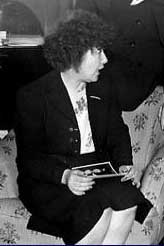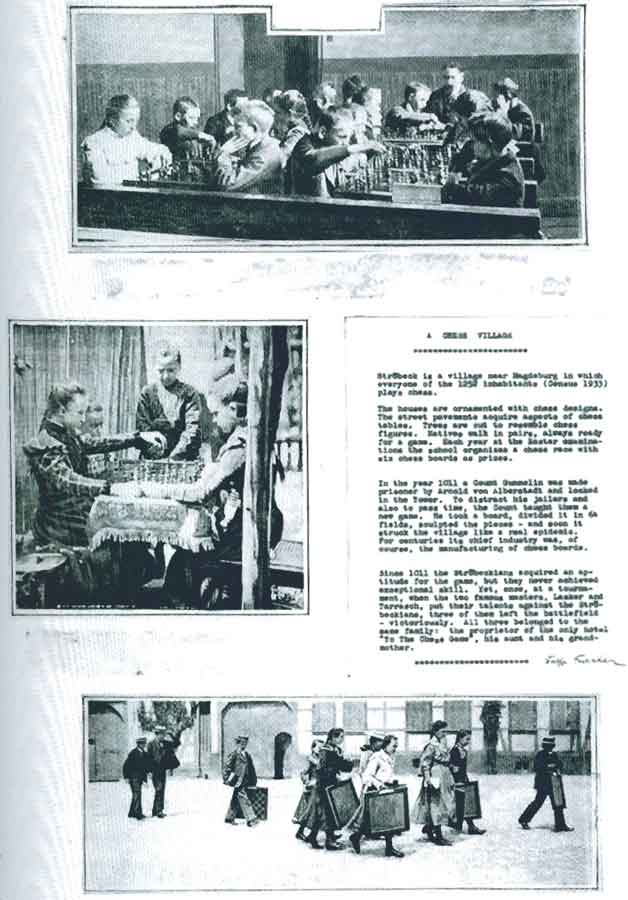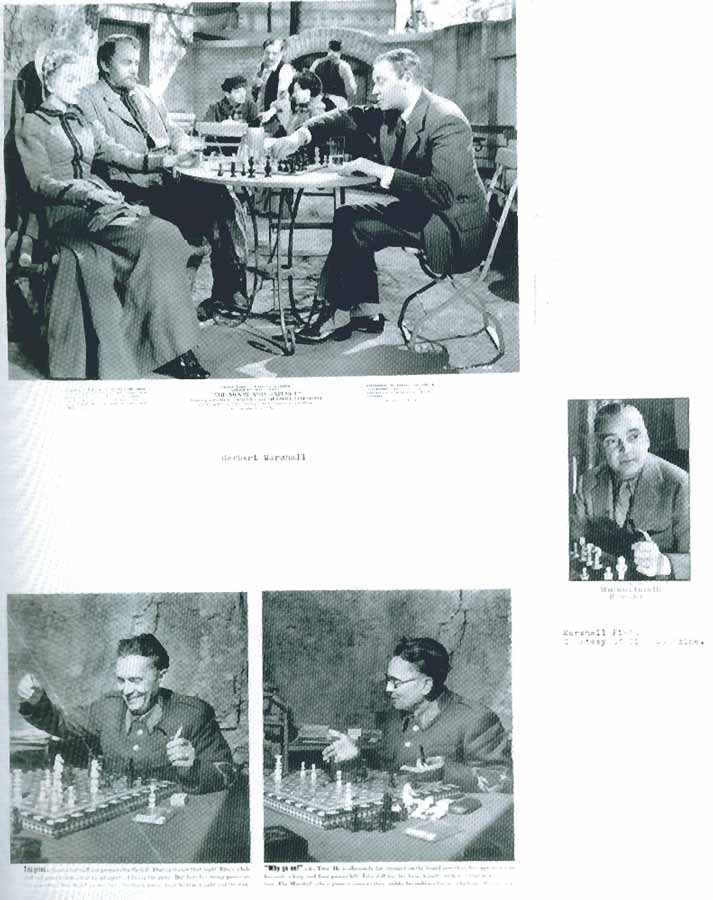|

Steffi Kiesler - early 1940's
Stephanie (Stefani, Stefi, Steffi ) Frischer was
born in Austria in 1897. As a philology student. she married theater and
art-exhibition designer, Frederick John Kiesler, in Vienna in 1920. In 1926,
they emigrated to New York where Frederick obtained an architects license in
1930. Frederick Kiesler went on to become quite famous for his avant-garde
designs. Steffi, meanwhile, became a librarian (in 1927) in the French and
German section of the New York Public Library, a position she held for 32 years.
Steffi Kiesler died in 1963.
Steffi Kiesler's two contributions to the show were
a pair of photmontages - the only photomontages (which were mainstays of the
Surrealist movement) and, besides that of André Breton, the only submission that
included personal text.
A Chess Village

|
The above text (written by
Kiesler) reads:
Ströbeck is a village near Magdehurg in which everyone of the 1252
inhabitants (Census 1933) plays chess.
The houses are ornamented with chess designs. The street pavements acquire
aspects of chess tables. Trees are cut to resemble chess figures. Natives
walk in pairs, always ready for a game. Each year at the Easter
examinations the school organizes a chess race with six chess boards as
prizes.
In the year 1011 a Count Gunnelin was made prisoner by Arnold von
Alherstadt and locked in the Tower. To distract his jailers and also pass
the time, the Count taught them a new game. He took a hoard, divided it in
64 fields, sculpted the pieces—and soon it struck the village like a real
epidemic. For centuries its chief industry was, of course, the
manufacturing of chess hoards.
Since 1011 the Ströbeckians acquired an aptitude for the game, but they
never achieved exceptional skill. Yet, once, at a tournament, when the two
famous masters, Lasker and Tarrasch, put their talents against the
Strobeckians, three of them left the battlefield—victoriously. All three
belonged to the same family: the proprietor of the only hotel “To the
Chess Game”, his aunt and his Grandmother.
*******************
Steffi Kiesler
|
For the record, there doesn't seem to be any
substance to the story in the last paragraph that three members of a family from
Ströbeck beat both Lasker and Tarrasch. In fact, the game of chess popular in
that village is actually a variant of the game.
The book, Imagery of Chess Revisited
expresses the sentiment that "Kiesler’s
description of Ströbeck as a “chess village” is consistent with those found in
recent studies by chess scholars J. C. Hallman and Marilyn Yalom."
The fact is that Schachdorf Ströbeck
was known about a century before the original Imagery of Chess show and
written about by H. R. J. Murray in his seminal, A History of Chess,
published in 1913.
For more on
Schachdorf
Ströbeck
Is Chess a Martial Game?

The top picture is a still from a film entitled
The Moon and Sixpence, adapted from a play of the same name by Somerset
Maugham.
[Albert Lewin, the harvard-trained
poet-turned-movie-producer who was one of Man Ray’s most devoted West Coast
patrons. Lewin, like Walter Arensherg, Duchamp’s patron, was a devoted chess
player.137 He managed to incorporate at least one chess scene in each of his
films and commissioned works of modern art for inclusion as well. In the
photograph, a chess game is taking place at the center of a garden café, with
the actor Herbert Marshall making his move. Beneath the photograph a typewritten
label on translucent paper reads simply “Herbert Marshall.” Diagonally below the
right-hand corner of the photograph of Herbert Marshall is a small news magazine
photograph of the department- store magnate Marshall Field III, at a chessboard,
with the caption “He invaded.”] - from Imagery of Chess Revisited
The two photographs below feature Marshall Broz
Tito, dictator of Yugoslavia. One caption reads: “The Marshal’s chess game is
conservative, unlike his military tactics which are often daring.”
|

